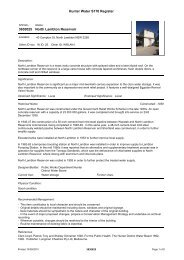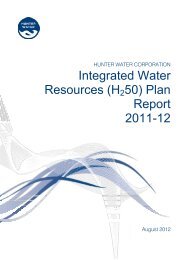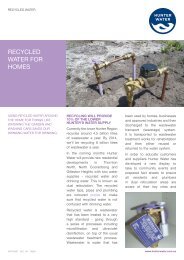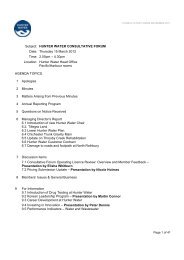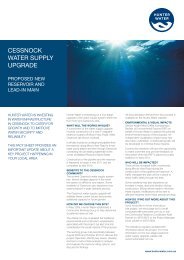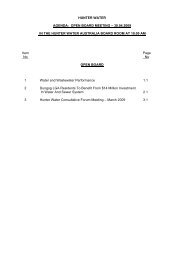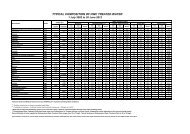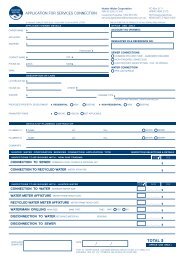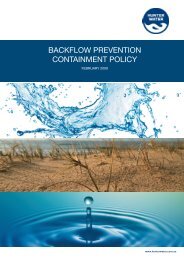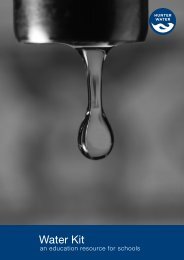Catchment Management Plan - Hunter Water
Catchment Management Plan - Hunter Water
Catchment Management Plan - Hunter Water
You also want an ePaper? Increase the reach of your titles
YUMPU automatically turns print PDFs into web optimized ePapers that Google loves.
<strong>Hunter</strong> <strong>Water</strong>’s operations are regulatedby the NSW Government on behalf ofthe community through a number ofregulatory instruments:• The main regulatory instrument,the Operating Licence, requires<strong>Hunter</strong> <strong>Water</strong> to meet AustralianDrinking <strong>Water</strong> Guidelines standards;• Extraction of water from theWilliams River and sandbedsis regulated by the NSW Officeof <strong>Water</strong> (NOW) within DECCW.NOW issue <strong>Water</strong> <strong>Management</strong>Licences that require environmentalconditions are met.• The performance of <strong>Hunter</strong> <strong>Water</strong>’swastewater system is regulatedby DECCW through EnvironmentProtection Licences. The licencesstipulate both quality and quantityconditions for discharge from eachwastewater treatment works and arereviewed every three years underthe legislation.1.3 The AustralianDrinking <strong>Water</strong>Guidelines<strong>Hunter</strong> <strong>Water</strong> has recently adoptedthe ‘catchment to tap’ approach thatis recommended by the AustralianDrinking <strong>Water</strong> Guidelines (theGuidelines) to manage the risksassociated with drinking water quality.DECREASING level of protectionno barrierssingle barriersmultiplebarriersadvancedmultiplebarriersLOWThe Guidelines recommend thatbest practice drinking water qualitymanagement is achieved using amultiple barrier process. This approachis based on the premise that no singletreatment mechanism is infallible; each‘barrier’ reduces risk to water qualityincidents when it is applied in a robustmanner. Figure 2 demonstrates thatas a greater number of robust barriersare implemented, public heath risk isreduced proportionally.1.4 The need to managedrinking watercatchments• The Lower <strong>Hunter</strong> RegionalStrategy predicts that an additional160,000 people will reside in the<strong>Hunter</strong> by 2031. The Departmentof <strong>Plan</strong>ning has identified thatmost housing will principallybe developed on ‘greenfield’sites, some within drinking watercatchments. It is recognised thatincreasing development and landuse pressures in the catchment ofsource waters causes a decline inraw water quality and a resultantincrease in risk to the security ofdrinking water.• A decrease in the quality ofraw water supplied to drinkingwater treatment plants requiresan increase in the treatmentinfrastructure required (egpublic health riskMEDIUMlevel of activity in catchmentHIGHlow medium highozonation, advanced oxidationprocesses). The implementation ofthese advanced treatment methodsincreases the cost of water tocustomers.• Increasingly complex treatmentmethods require more energy,which has adverse greenhouse gasimplications.• Poor quality source water requiresincreased chemical dose rateswhich increases cost to theconsumer. Source water withvariable quality is also more difficultto treat as chemicals must beadjusted to optimise the treatmentprocess. Rapid change in qualityof source water is recognised asa high risk period for water qualityincidents.• Given that <strong>Hunter</strong> <strong>Water</strong> applies amulti-barrier approach to managingdrinking water quality, the mostefficient allocation of resourcesfor catchments and treatmentneeds to be considered. Thecosts associated with managingcatchments needs to be balancedagainst the cost of increasedtreatment. Detailed cost-benefitanalysis are currently underwaythat weigh the cost and benefit ofcatchment management againsttreatment (see Wells, in progress).In the interim, <strong>Hunter</strong> <strong>Water</strong>recognises that expenditure on bothtreatment plants and catchmentmanagement is necessary.1.5 The strength of theWATER QUALITY barriersin <strong>Hunter</strong> <strong>Water</strong>’scatchmentsThe Guidelines recommendstrengthening six (arbitrary) barriersfor the preservation of quality drinkingwater. <strong>Catchment</strong> management andsource water protection provide the firstbarrier and various engineered solutionsto reduce the risk of disease are placeddownstream of catchments and dams.It should be noted that downstreamsolutions such as treatment cannotalways be relied upon in isolation:Figure 2: Effect of increasing the number of barriers for protection of drinking water.CATCHMENT MANAGEMENT PLAN . ssS . 001 . JUNE20107




